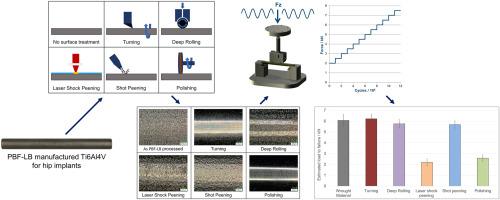通过适当的后处理提高激光粉末床熔合Ti6Al4V髋骨的疲劳强度。
IF 3.5
2区 医学
Q2 ENGINEERING, BIOMEDICAL
Journal of the Mechanical Behavior of Biomedical Materials
Pub Date : 2025-10-06
DOI:10.1016/j.jmbbm.2025.107221
引用次数: 0
摘要
由于与变形材料相比,LPBF制造的Ti6Al4V合金的抗疲劳性较低,尽管患者特定关节置换术具有优势,但仍采用传统方法制造髋关节干。因此,本研究的目的是研究适当的后处理,以提高LPBF制造的Ti6Al4V合金的抗疲劳性能,使用四点弯曲装置和定位试验。结果表明,只有热等静压工艺和充分的表面处理相结合才能产生与变形材料相似的疲劳结果。因此,机械加工、深滚和喷丸处理是合适的表面处理方法。对于复杂的几何形状,如髋杆,喷丸强化是最充分的表面处理。喷丸强化和抛光相结合的表面处理与单独喷丸强化处理产生的疲劳效果相似。由此可以看出,喷丸强化与先前的热等静压工艺相结合,可以产生与锻造材料相当的令人满意的疲劳结果,并且可以应用于复杂的几何形状,如髋杆。此外,髋关节茎的肩部和颈部区域可以在hip工艺和喷丸强化程序后抛光,而不会降低疲劳强度。本文章由计算机程序翻译,如有差异,请以英文原文为准。

Increasing the fatigue strength of laser-powder bed fusion manufactured Ti6Al4V hip stems by means of appropriate post-treatments
Due to the lower fatigue resistance of LPBF manufactured Ti6Al4V alloy compared to wrought material, hip stems are still manufactured conventionally, despite the advantages of patient-specific joint replacements. Therefore, the aim of the study was the investigation of appropriate post-treatments to increase the fatigue resistance of LPBF manufactured Ti6Al4V alloy using a four-point bending setup and a Locati-test. The results showed that only a combination of a hot isostatic pressing process and a sufficient surface treatment can lead to similar fatigue results as wrought material. Thereby, machining, deep rolling and shot peening turned out to be suitable surface treatments. For complex geometries like hip stems, shot peening is the most sufficient surface treatment. A combined surface treatment of shot peening and polishing led to similar fatigue results as the shot peening process alone. It can be followed that a combination of shot peening with a previous hot isostatic pressing process leads to satisfying fatigue results comparable to the wrought material and can be applied on complex geometries like hip stems. In addition, shoulder and neck area of a hip stem can be polished after the HIP process and the shot peening procedure without any reduction in fatigue strength.
求助全文
通过发布文献求助,成功后即可免费获取论文全文。
去求助
来源期刊

Journal of the Mechanical Behavior of Biomedical Materials
工程技术-材料科学:生物材料
CiteScore
7.20
自引率
7.70%
发文量
505
审稿时长
46 days
期刊介绍:
The Journal of the Mechanical Behavior of Biomedical Materials is concerned with the mechanical deformation, damage and failure under applied forces, of biological material (at the tissue, cellular and molecular levels) and of biomaterials, i.e. those materials which are designed to mimic or replace biological materials.
The primary focus of the journal is the synthesis of materials science, biology, and medical and dental science. Reports of fundamental scientific investigations are welcome, as are articles concerned with the practical application of materials in medical devices. Both experimental and theoretical work is of interest; theoretical papers will normally include comparison of predictions with experimental data, though we recognize that this may not always be appropriate. The journal also publishes technical notes concerned with emerging experimental or theoretical techniques, letters to the editor and, by invitation, review articles and papers describing existing techniques for the benefit of an interdisciplinary readership.
 求助内容:
求助内容: 应助结果提醒方式:
应助结果提醒方式:


